[Live] Iraq Warlogs: Interface the leaks
Wikileaks publishes 400.000 classified documents from the U.S. Departement of Defense related to the Iraq War. Explore them through our collaborative application.
This article will be updated throughout the day, depending on the evolution of our crowdsourcing work.
Click here to launch the application
[00:00] Live-blogging is now over
To follow the evolution of the situation, please go to our articles tagged with “WikiLeaks”
[23h37] Julian Assange speaks out
Speaking at the Frontline Club in London with Daniel Ellsberg (the man fom the “Pentagon Papers“), Julian Assange highlighted the difference between the media partners in handling the logs, “although they all had the same starting point”, and stressed the role of television to reach the masses. Paying tribute to the “good people in the Pentagon” who provided the documents, the WikiLeaks’ leader has also sent a warning to the governments: “Knowledge will forever govern ignorance.”
[23h45] Dans Mother Jones, Kristin Hrafnsson, an Icelandish spokesperson for WikiLeaks, explained why the organization gave unredacted documents to their media partners:
At the outset, you decide that basically everything in all the reports is harmful until proven otherwise. So little by little, you approach the material and reinstate words, locations, et cetera…There [are] of course limited resources, but the end result, whether it takes weeks or months, should be very limited and just the necessary redactions for harm limitation, so we can possibly call on academic institutions or other media organizations to help out in that progress.
[20:36] A new mission for soldiers: Recovering drones
Browsing through the Warlogs, Aviation Week discovered an unknown reality: with the proliferation of UAVs (“Unmanned Air Vehicles” or UAVs in military terms), the coalition troops had to develop a new skill: how to recover aircrafts shot down behind the enemy lines. Though not as much as the $4.5 million of the Predator drone - heavily used on the Pakistani-Afghan border – the unit cost of an RQ-2 Pioneer is $1 million, a figure which partly explains this new prerogative. Thus, there are no fewer than 322 hits on “UAV crash” and 277 for “UAV recovery“.
As Aviation Week notes, drones are small technology gems that Iraqi insurgents are keen to take apart if found after a crash:
From February [2005], another report details how a UAV crashed in a residential neighborhood, and when American forces arrived, they were told that they are too late—a white car has already picked the wounded bird up and driven off with it in their trunk.
Iraqi Prime minister riled by WikiLeaks revelations
Seven months after the hectic legislative elections in which the coalition Nouri al-Maliki led was overtaken – for two seats – by the Iraqiya movement of Iyad Allawi, al-Maliki blamed Julian Assange’s organization for manipulating the people, while the presidential election draws closer. “The documents are used against national parties and leaders, especially against the Prime minister”, said a spokesperson.
[17:30] Maysoun al-Damlouji, a spokeswoman for the Iraqiya alliance, which owns a majority of seats in the Parliament, said in a statement that the WikiLeaks documents showed the need for power-sharing in Iraq. “Putting all the security powers in the hands of one person who is the general commander of the armed forces [has] led to these abuses and torture practices in Iraqi prisons”, she said.
[16:25] Nick Clegg calls for an investigation over abuse claims
Following the stories of torture and abuse committed by coalition forces against prisoners in Iraq, Deputy Prime Minister Nick Clegg calls for an investigation. Quoted by The Guardian, the leader of the Liberal Democrats estimates that the allegations contained in the WikiLeaks documents are “extremely serious” and considers it vital to know if “the rules of war have been broken”. Interviewed by the BBC1, Clegg also urged the U.S. to give a clear position on the subject:
We can bemoan how these leaks occurred, but I think the nature of the allegations made are extraordinarily serious. They are distressing to read about and they are very serious. I am assuming the US administration will want to provide its own answer. It’s not for us to tell them how to do that.
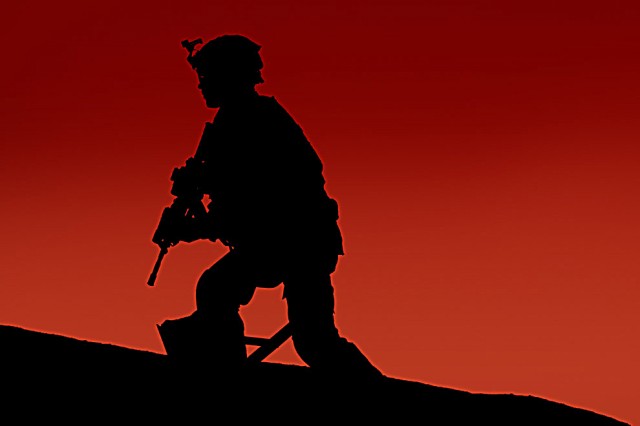
[23:37] “The ISP should block Wikileaks”, according to the former AOL chairman
On his blog, Barry Schuler, the former AOL chairman violently attacks WikiLeaks, accusing the organization of threatening “the Internet as we know it” . From his point of view, “anyone who holds a classified clearance is committing a crime” if they decide to transmit files to a third structure. The businessman goes even further by drawing an analogy with the debuts of Napster, while insisting on the fact that [Wikileaks] can kill , not peer-to-peer.
For Schuler, the publication of Warlogs shows the need for regulation of the web, in order to avoid information overflow and preserve some form of morality. Mentioning the blocking of pornography websites, he urges the Federal Communications Commission (FCC, the government agency responsible for telecommunications) and Internet service providers to consider the possibility of a blackout, to put Wikileaks our of order.
The question of PMCs
“Death came suddenly, from all sides, in all forms”. That is the conclusion both elliptical and unequivocal that stands the New York Times draws when talking about the role of business companies in Iraq especially the famous private military companies (PMCs), embodied in the popular imagination by Blackwater. The article recalls that the influx of mercenaries in 2004 was related to a simple problem: in the mind of the coalition, there were not enough soldiers to fight.
Looking through the logs, the New York Times is stunned by the general mayhem that prevailed between the U.S. military, Iraqi forces and employees of security companies. In addition, the absence of a protocol on rules of engagement would have killed scores of civilians, while it would have endangered the lives of the employees themselves, as shown in this undated episode:
At a notoriously dangerous checkpoint on the main road to the Baghdad airport, a cement truck entered a lane reserved for Department of Defense vehicles. A guard from Global, a British company, fired a warning shot, and when a man initially identified as an Iraqi opened the door and tried to flee, guards from a tower started firing, too. The man dropped to the ground. Then members of an Iraqi private security team parked nearby also opened fire, shooting through the chest not the driver but a worker from DynCorp International, an American security company.
When the truck driver was finally questioned, he turned out to be a Filipino named José who worked with yet a third company, KBR, the American logistics and security giant.
The conclusion drawn from this chaos was, “IT IS BELIEVED THE DRIVER ENTERED THE DOD LANE BY ACCIDENT.”
According to a recent report by the Congressional Research Service (view PDF), there were 95,461 employees private companies in Iraq in March 2010, for 95,900 troops, a ratio of 1.1.
“Wikileaks goes Iraq”
On the website of Le Monde, the illustrator T0ad delivers his version of the leak coordinated by Wikileaks:
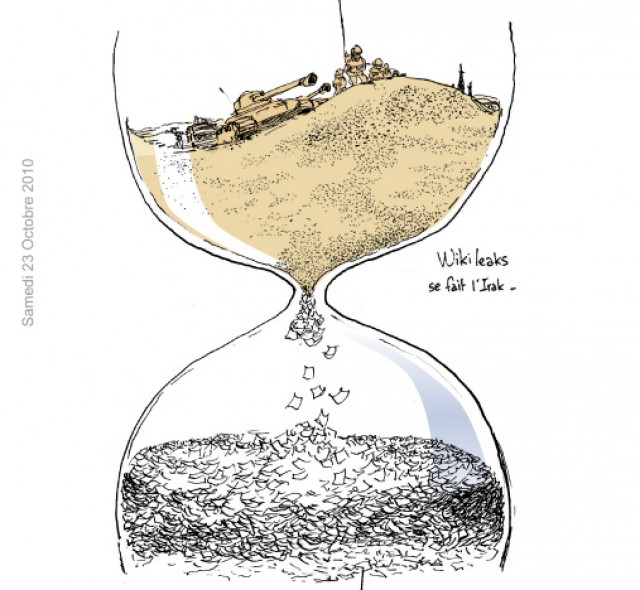
[15:49] How many abuses?
The “incident reports” published by Wikileaks contains only a forty cases of serious abuse committed by U.S. troops against Iraqi prisoners. This figure is very low. But these forty cases don’t identify all the cases of abuses against prisoners between 2004 and 2009: from mid-2007, a change in procedures did pass this information through another channel. The accusations of abuses are no longer recorded in “incident reports”. In fact, these reports only record the cases detected or suspected by the soldiers on the ground.
If American soldiers apparently followed instructions to back the accusations of brutality against civilians and suspects, a major question remains: the number of brutality that have simply not been the subject of an alert or have been camouflaged. The report on the massacre of Mahmudiyah during which soldiers from the 101st Airborne Division killed a father, his wife and 6 year-old daughter, before raping and kill her 14 year-old one, merely mentions the discovery of the bodies of four civilians “killed by insurgents.”
[18:37] Some examples of visualization
Al-Jazeera developed an interactive timeline that show more than 65.000 incidents in Iraq.
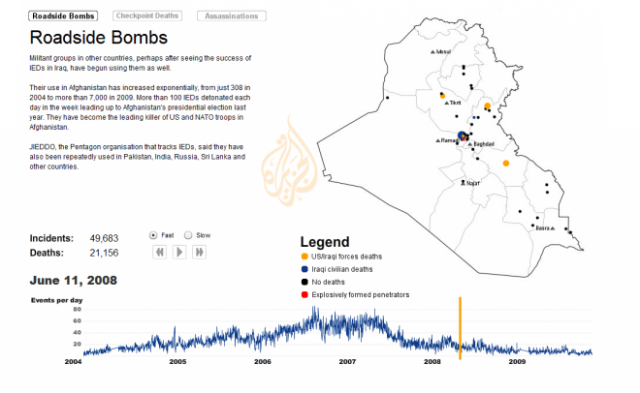
The swedish TV channel SVT chose an histogram establishing the deaths’ typology.

Channel 4 chose to focus on prominent facts, notably listing the Hellfire missiles attacks.
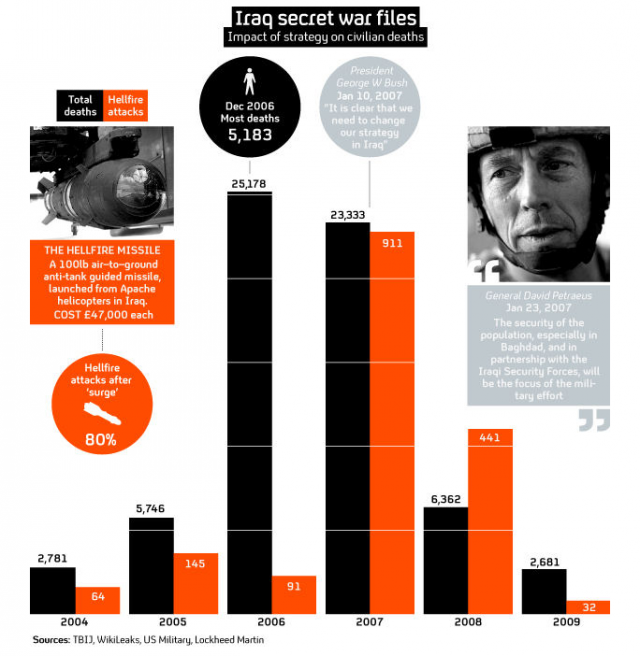
[3:18] Fox New’s website has quoted Pentagon spokesman Geoff Morrell who defined the document release “deplorable” and said he’s concerned about “harm that could come to our forces.”
[3:02] WikiLeaks brings attention to the unprecedented number of articles published in the last four hours : 1400 articles.
Check out the teasing video produced by the Bureau Of Investigative Journalism, which has been given three months ago and has done a really good job.
Blackwater: nothing found
When the Afghan Warlogs came out, WikiLeaks was severely criticized for not having been cautious enough, leaving some informants’ names on some logs.
It seems that Julian Assange took those critics pretty seriously: in the recently released Warlogs, all names have been hidden, whether they were soldiers, locations or private companies. Thus, a search run on ‘Blackwater’ (a private security firm whose actions have been criticized) terms gives no results.
How come news outlets who had been given access to the logs several weeks ago reported on serious casualties caused by Blackwater? Have handed two different versions of the database in order to avoid criticisms?
[01h59] Iraq mourns
The Guardian has published a map of the deaths on Iraqi soil (red dots):
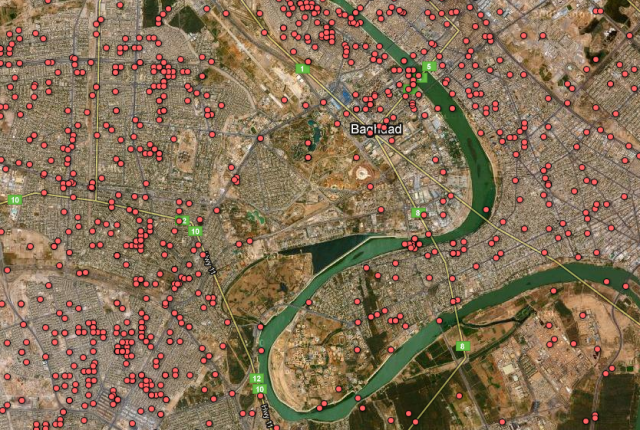
Wikileaks hacked while preparing Warlogs ?
[01:54] According to Andy Greenberg, who runs the blog ‘Firewall’ on Forbes, Wikileaks had been under attack while preparing the War Logs leak. According to an anonymous source, “very skilled” hackers had compromised the server used by the organization to encrypt its instant messages, located in Amsterdam.
This incident might had have them transfer their activities to another server in Germany. While Wikileaks is officially “under maintenance” for long weeks, this intrusion into their system might be the first of its kind, and could be an explanation for the cryptic tweet – who coined the expression “Activate Reston5″ into a meme – posted on the evening of october 21st.
[01:10] Jay Rosen on the BBC: “We don’t actually know that anybody was harmed from the previous releases and the Pentagon has said no significant information was contained in them, however WikiLeaks sustained a lot of criticism for them and has tried harder this time to bolster its legitimacy”
People will always try to characterise WikiLeaks as a rogue actor now matter how legitimate they are
So far the US Govt has only commented through Secretary of State Hillary Clinton and a NATO official who have condemned “in the most clear terms the disclosure of any information by individuals and or organisations which puts the lives of United States and its partners’ service members and civilians at risk”.
[23:50] BBC New reviews tomorrow’s papers. In the UK only The Guardian has put the Iraq War Logs on its front page.
Jay Rosen on the BBC: “We don’t actually know that anybody was harmed from the previous releases and the Pentagon has said no significant information was contained in them, however WikiLeaks sustained a lot of criticism for them and has tried harder this time to bolster its legitimacy”
People will always try to characterise WikiLeaks as a rogue actor now matter how legitimate they are
[0h22] Though the 2003 intervention was partly motivated by the presence of torture chambers built by the Saddam regime, it has emerged these chambers still exist and many cases of torture have been reported since the beginning of the conflict.
Among the plethora of reports collected by Wikileaks, one of them evokes an attempt to escape the prison of Abu Ghraib, on the symbolic date of September 11, 2009. New details shed light on the incident, which had been covered in the press at the time. We learn that the riots started “for myriads of reasons,” and that “a guard opened fire on three prisoners, wounding all.”
In addition, the U.S. military appears to show concern of the negative impact of such an event in the region, at a time when are power relations already fragile.
True to its policy, the Defense Department has sought to minimize the impact of the revelations before their publication, while emphasizing the potential danger they pose to the troops. Dave Lapan, a spokesman at the Pentagon, was particularly concerned about the consequences of a mass exodus of “the troops or Iraqis working with Americans.”
[23:39] – Jeff Jarvis tweets: “Now nothing, even war, can be done in secret. The transparent age will first expose the bad before preventing it“
6:59 pm GMT, Al-Jazeera posts its trailer
WikiLeaks publishes the list of media partners
On its Twitter account, WikiLeaks announces a first list of editors to whom it has sent documents: The Bureau of Investigative Journalism, IBC, The Guardian, Der Spiegel, The New York Times, Le Monde, Al Jazeera, Channel 4, SVT (Swedish television), CNN and the BBC.
“We maximise impact”, the organisation added.
Revelations include details on secret prisons, the role of Blackwater in Iraq and new torture allegations. The US army also neglected reports of torture, rape, murder, and abuse and turned a blind eye on the behaviour of Iraqi police and soldiers, The Guardian reports. The archives show hundreds of reports of beatings, burns, lashes, amputations and dissolving bodies in acid.
We knew that some detainees had been tortured in Iraq by soldiers of the U.S. Army. The newly released documents have also shown that the army and Iraqi police also tortured some of their own prisoners.
The U.S. military documents identify at least six prisoners who died in jails in Iraq. In one of these documents, the U.S. military suspects the Iraqi forces have cut off the fingers of an inmate and then burned his body with acid. The archives show hundreds of reports of beatings, burns, and lashes. Apparently, in most cases, the U.S. military seems to have abandoned any investigation, leaving this responsibility to the Iraqi authorities.
The US army made a conscious decision to not intervene when the abuse concerned an Iraqi victim and an Iraqi offender.
The Guardian is reporting rumours that the electronic archive originates “from the same dissident US army intelligence analyst who earlier this year is alleged to have leaked a smaller tranche of 90,000 logs chronicling bloody encounters and civilian killings in the Afghan war.” This is a clear reference to Bradley Manning.
Almost 400,000 logs have been released, this amounts to more than 38 million words, but as with the previous WarLogs the language used appears to be heavily cryptic.
It has been revealed that despite claiming otherwise, the coalition forces have kept an estimate on civilian deaths since the war began in 2003. The estimate has now been raised to 125,000 civilian deaths – amongst them 66,081 civilians, 23,984 insurgents and 15,196 Iraqi security forces. The raw numbers reveal it was civilians who paid the heaviest toll in this conflict. The civilian deaths are reported only in the areas where the US army was operating. The bloodiest hot spot was Baghdad.
Julian Assange on Al Jazeera explains the decision to publish this information now: “[shortly] before the congressional elections. In terms of media timing it is wise to release this material now, where it can have an impact”.
JA has claimed the FBI had travelled to Wales to seek out people involved with WikiLeaks and put pressure on the UK, Sweden, Australia and Iceland in relation to him or his associates.
“Make no mistake, soldier”
Alarmed by the Bradley Manning case and eager to prevent leaks, the Pentagon has set up an application for soldiers. On a khaki green background, a pixelated GI Joe explains how the SAEDA program (for Subversion and Espionage Directed Against the U.S. Army), established in 1993 to prevent military leakage, can be efficient. On a threatening tone reminiscent of Sergeant Hartman from Full Metal Jacket, the little figure launches a warning, only after citing the example of a first class who spent three years in prison:
Make no mistake about it soldier, this is serious business. And remember, when these guys put our national security at risk, they’re putting your country, and you, and your unit, and your family at risk.
On October 7th, the Defense Department had just amended the SAEDA, encouraging soldiers to report suspicious behavior to their superiors (see the 31-page report in PDF). At the time, Robert Gates’s teams had denied any link between their decision and the threat posed by Wikileaks.
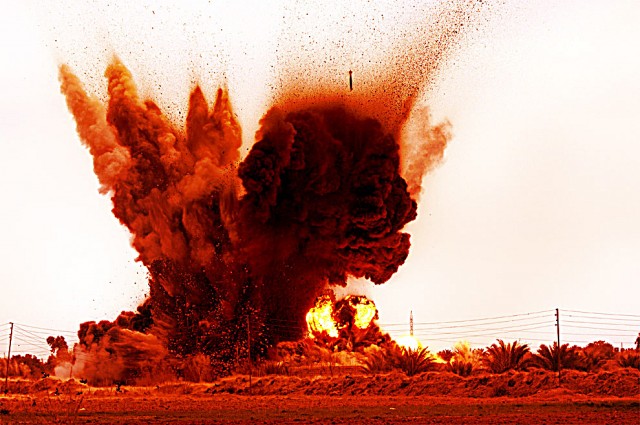
The U.S. government reiterates its warnings
True to its policy, the the Department of Defense has sought to minimize the impact of the revelations of Wikileaks before their publication, while emphasizing the potential danger they pose to the troops. Dave Lapan, a spokesman at the Pentagon, was particularly worried about the consequences of a mass leak for “the troops and Iraqis working with Americans”.
Power struggles around Abu Ghraib
Among the plethora of reports collected by Wikileaks, one of them evokes the attemp of three inmates to escape the prison of Abu Ghraib, on the symbolic date of 9/11, 2009, and sheds new light on the incident, mentioned in the press at the time. We learn first that the riots started “for myriad reasons”, and that “a guard opened fire on three prisoners, wounding all of them”.
In addition, the U.S. military is concerned about the negative impact of such an event in the region, capable of reversing power struggles that are already fragile. “Political leaders are using this incident to draw attention to their party, it says.” Each leader wants to be seen as the voice of the populous, and minority political parties are using this event to cast a negative light on the current ruling parties. The prison abuse scandal and pictures are still fresh in the mind of local citizens, and political leaders draw correlations between abuse at the prison and the ruling political parties.”
Find here our first Warlogs app, our liveblogging of the previous leak, and all our articles tagged with “WikiLeaks”
In the middle of July, Wikileaks released 77,000 confidential documents relating to the U.S. military intervention in Afghanistan, an event we dubbed “the biggest leak in the history of war“. On that occasion, OWNI created an application aimed at untangling the overlap and overload of information. The site administrators, chief among them founder Julian Assange, came under fire from the Pentagon. Despite the internal strife and the attempts to knock the organisation down, this Friday they published a new salvo of 400,000 classified files relating, this time, to the war in Iraq, just two months after as the U.S. military completed its official withdrawal. For the occasion, Wikileaks directly appealed to OWNI to develop a new version of the application.
While the Pentagon has urged the media not to publish the leaks, we feel it represents a step ahead towards conflict transparency, at at time when war remains one of the last taboos, subject to inertia and secrecy. With the rise of augmented wars, it is logical that journalism gets augmented as well, and in our view:
Transparency leads to credibility. In a war started by lies the media were not able to bust effectively, not to give the public all the documents we have access to would amount to nothing less than petty obstruction. On the contrary, publishing them in the most intelligible form possible allows any one to form his or her opinion based on hard documents and reinforces the link of trust between the journalist and his or her audience.
Our interactive timeline, regularly updated, will help you keep track of the events of the past ten weeks (scroll from left to right):
Did the Pentagon try to bypass WikiLeaks?
To anticipate the leak of Iraqi War Logs, the Department of Defense set up a team of 120 soldiers ready to dissect all records posted by Wikileaks. Led by Brigadier General Robert Carr, Director of Defense Intelligence and HUMINT (stands for “Human Intelligence”), this task force also includes employees of the FBI. Contacted by OWNI, the Pentagon provided some clarification. According to press officer Major Christopher Perrine this unit was created “on July 28, at the request of the Secretary of Defense”, three days after the publication of the Afghan War Logs. Since then, the cell studied the materials with a magnifying glass, for “16 hours a day”.
Moreover, on October 17th – a few days before the newest publication – Cryptome, the website run by John Young, a veteran of open government, reported on a publication from the DoD: by posting 236.000 “Significant Activities” (SIGACTS) of the allied forces in Iraq between 2004 and 2007, compiled in 8460 pages, did the Pentagon seek to preempt the operation initiated by Wikileaks?
Once again, the Defense Department is weighing the charges that could be made against them: “These documents were posted on our website following a request for declassification under the Freedom of Information Act (FOIA) and are not connected to Wikileaks”, said Major Perrine. However, this thick glossary is not without interest when analyzing the logs provided by WikiLeaks. On 8,460 pages, 8,451 refer to IED (for “Improvised Explosive Device”), reminding those who have not seen The Hurt Locker that the Iraq war was a counter-insurgency conflict, just like the war in Afghanistan. On a separate note, one can identify “Abu Ghraib” (the city, not the secret prison) in no less than 2,408 pages, showing an intense activity in the suburbs of Baghdad, especially around the airport, viewed as one of the toughest zones in the whole country.
__
Martin Clavey, Federica Cocco, Guillaume Ledit, Olivier Tesquet, Martin Untersinger
Credits: Flickr CC The US Army





Laisser un commentaire